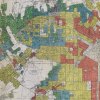Biddy Mason and the Founding of Los Angeles: From Slavery to Entrepreneurship

The story of Bridget “Biddy” Mason is a tale truly reflective of the Los Angeles dream narrative. It is a story defined by emancipation, entrepreneurship, diversity and breaking boundaries. Biddy Mason, though seldom discussed, should always be revered as an icon within our ever-dynamic city. Born in 1818 as a slave, Biddy, (it must be made clear that enslaved people did not have legal surnames) had multiple masters in South Carolina, Georgia and Mississippi before being acquired by Robert Marion Smith of Mississippi as a possible wedding gift to his new bride. As a slave on the Smith farm, she became highly valued for her knowledge in herbal medicine, livestock care and midwifery, and all of these skills would ultimately be thoroughly utilized by the Smith family when in the 1840s, Robert Marion Smith decided to move his family to Utah Territory. Since 1839, Mormon missionaries canvassed the state of Mississippi seeking converts. Though deeply unpopular in most of the state, the Smiths converted to Mormonism and joined the “Mormon Exodus” to Utah. Like so many enslaved people during westward expansion, Biddy and her fellow slaves were compelled to join their owners. When Biddy, her fellow slaves, and three small children arrived in Utah Territory, they had “walked 1,700 miles behind a 300 wagon caravan.” It is likely that they cared for their owners throughout the trip while working to ensure their own survival and well-being of their children.

While slavery in Utah was sparse, the Utah Territory legislature legalized slavery in 1852 “although the law cautioned against inhumane treatment and stipulated that slaves could be declared free if their masters abused them.” This allowed Biddy and her children to remain enslaved in Utah until Robert Marion Smith agreed to be sent to Southern California to help found a Mormon community though he was cautioned by Brigham Young that California had outlawed slavery and held a low tolerance for slave owners seeking to keep slaves within state borders. Regardless, Smith ventured into Southern California with Biddy and a number of other enslaved people and established a home in San Bernardino. The trek to California was fortuitous as she crossed paths with free black people eager to inform her that California outlawed slavery in 1850 and encouraged her to sue for her emancipation. Further encouraging such a bold move was the blossoming relationship between her oldest daughter, Ellen, and the son of well-off black rancher Robert Owens. In 1856, Robert Marion Smith feared that disapproving neighbors would force him to emancipate his slaves and opted to smuggle them out of the state and sell them in Texas. Robert Owens alerted the sheriff about the disappearance of Smith and his slaves and a posse of ranchers, cowboys and vaqueros intercepted Smith, preventing him from traveling to Texas. Biddy and others within Smith’s enslaved community later petitioned for their freedom, which was eventually granted.
Biddy Mason’s emancipation led her to establish herself in Los Angeles where she worked as a midwife and nurse for Dr. John Strother Griffin, famous for being one of the first formally trained doctors in Southern California and “Father of East Los Angeles.” Making $2.50 per day, she “would eventually deliver hundreds of babies in Los Angeles” and ultimately, early Los Angeles residents affectionately referred to her as “Aunt Biddy.” Many records also assert that she became a Spanish speaker, thus fostering her friendship with former Governor Pio Pico. Pico encouraged her to invest her money wisely and purchase property.
In 1866, Biddy Mason purchased her first piece of property for $250 on Spring Street between Third and Fourth Street. She purchased a number of other properties around the downtown area as well, but was known for her civic investment and overall generosity. Mason was noted for visiting local prisoners to offer prayer and comfort, founding a daycare for the children of local working mothers, donating food and money to the poor, but most significantly, she allowed her home to be the first meeting place of the First African Methodist Episcopal Church of Los Angeles. She later donated the land upon which the first church was built. When Mason passed away in 1891, she was as one of Los Angeles’ great philanthropists and left her heirs a fortune estimated at $3 million. Robert Owens, her grandson and predominate heir credited her with ensuring that he become more than a mere landed farmer recalling, “She told my father that he could not make a farmer or a blacksmith out of a boy who wanted to be a politician, and she was right.” Though she never learned to read or write, she ensured that her descendants were some of the most influential and civically invested black citizens in the American West, thus carrying on her legacy of resilience and care.
Top Image: This image is widely considered the earliest-known photograph of Los Angeles. | Courtesy of USC Libraries –California Historical Society Collection.






